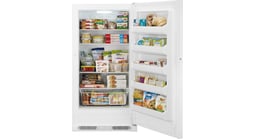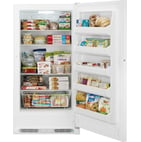Finding out why the walls of your White-Westinghouse upright freezer are hot
It's normal for the outer walls of the freezer to get warm or hot when the compressor is running; refrigerant lines inside the cabinet walls remove heat from the compressed refrigerant. The hot refrigerant helps control cabinet humidity to prevent the cabinet from sweating.
If the walls get extremely hot, the condenser fan could be malfunctioning. The condenser fan blows air across the condenser coils to help cool the compressed refrigerant before it enters the evaporator. Replace the condenser fan if it doesn't run when activated.
Dirty condenser coils can also cause the hot freezer walls. Dust build-up on condenser coils interferes with heat transfer so the refrigerant stays hotter as it leaves the condenser and travels through lines in the freezer walls.
Performing routine maintenance on the freezer can also help keep the freezer walls from getting hot. Cleaning dust from the compressor compartment grill can improve airflow across the condenser so the refrigerant is cooler as it goes through lines in the freezer walls. Replacing the door gasket can prevent air from leaking into the freezer compartment, causing the compressor to run longer and heating up the refrigerant travelling through lines in the freezer wall.
How to deal with excessive frost inside your White-Westinghouse upright freezer
Some frost inside the freezer is normal, because each time you open the freezer door, warm, moist air enters the freezer and forms frost. But if excessive frost forms quickly inside the freezer, it could be that a damaged door seal is constantly allowing warm, moist air into the cabinet, resulting in excessive frost. Check the door seal and replace the seal if damaged.
A crack in the plastic liner inside the freezer cabinet can also allow warm air into the freezer and cause frost. Check the inner liner and repair any cracks using a liner repair kit.
If you see frost on the evaporator cover in the back of the freezer and the freezer isn't cooling well, then a failure in the automatic defrost system could be causing the frost. If the defrost heating element that melts frost off the evaporator fins fails, frost will cake up on the evaporator and interfere with airflow and cooling in the freezer. A failed defrost bi-metal won't allow current to reach the heater so a failed defrost bi-metal will also cause frost on the evaporator and inhibit cooling in the freezer. A failed defrost timer won't advance into the automatic defrost mode so the defrost heating element would never turn on to melt frost off the evaporator. Check the defrost system if you see frost only on the evaporator cover.
When searching for freezer repair near me, trust your local pros at Sears Appliance Repair to fix your freezer fast. We have fast and reliable freezer repair service available in your neighborhood. Same day and next day repair appointments are available in many areas.

